new etsy shop


My beautiful new book of postcards is now available on my etsy shop.

They look great framed as a set.
Continue reading

My beautiful new book of postcards is now available on my etsy shop.

They look great framed as a set.
Continue reading
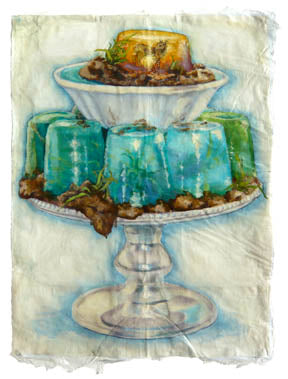


Continue reading


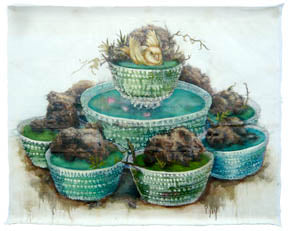
Clint called my paintings "culinary wilderness" when he was writing the description for the show invitation. Here's a little bit more about my art process.
Wheat Paste: formerly a fine art material that I used when printmaking or bookbinding. Now it is the familiar coating on every surface of my kitchen after cooking with my boys.
When I was writing and illustrating Cook Until Desired Tenderness, I worked the pastry and salad stations in two very nice restaurants in The City. The plating of food was a delicate art. The due date for my manuscript was the same as for my first baby. Then cooking and painting changed.
Cooking up a batch of wheat paste starts with the intention to make muffins. Stir together dry ingredients using two citrus juicers, a melon baler, two pairs of tongs, an ice cream scoop, two whisks, all the measuring spoons and cups, a bunch of stickers, a Lego, toothpicks…toothpicks? But toothpicks make better blow-darts then they do muffins. Show little brother how to insert a toothpick into a cocktail straw and shoot it out like a spitwad into the sugar canister, pick it out and suck on it then repeat, repeat, repeat, grab a slobbery handful of sugar and use the toothpicks for a swordfight. The muffin tin becomes an arcade game that is a mix of basketball and whack-a-mole. Clean up the floury mess with a bench scraper, used like a bulldozer, and a wet sponge. When the little brother wants to use the only sponge, the big brother convinces him to rub his bare stomach in the wheat paste instead. He tries, but it’s not good enough. Above the ensuing fight, I hear a distinctive shout, “LAUNCH.” The rolling pin. A red knot begins to form on the little brother’s forehead. Game Over
I used rabbit skin glue to make these new paintings. Cooking it smells just like cooking Knox or Jell-o. The subject of the paintings is a combination of my childhood art: mud pies, and my grown-up art: Still life oil paintings, and the culinary arts. First I make the actual mud pies, running around getting Jell-o in my garden and mud in my refrigerator. Then I photograph them. I print the pictures in many tiles on “rice paper” that I have crammed through my desktop printer. The tiles are reassembled and bonded to crinoline fabric using rabbit skin glue. This becomes the canvas on which I paint the still life, changing and adding to the photograph. Creating the sense of beauty and chaos that is food.
Continue reading

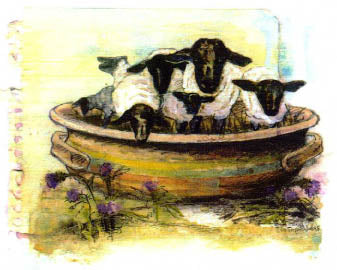
“It’s not Lambie-pie, it’s Jimmy-John.” I said to my older brother over dinner.
“It was Lambie-pie, but now it’s Lambie-chops, and you’re eating him,” he replied.
Lambie-Pie was an orphan that we bottle-fed with a glass milk bottle and a big pink nipple the size of a finger on a pair of rubber gloves. He walked right up to you in the pasture when all the other sheep fled in a frantic stampede. Jimmie-John was the mean old ram. My dad is the only one who speaks endearingly of the dull-witted menace. “If he got it in his mind to charge you, you could see it on his face way up the hill. By the time he got up enough speed and got close to you, you had enough time to pick up a two-by-four and whack him. Then he’d go rambling back up the hill.” Once he butted my brother so hard he flew head-over-heels into a feed bin. Jimmy-John wasn’t missed. But we didn’t eat him.
In 1968 my parents decided to leave the city and move “back to the land.” I was two, my brother was four, and we stayed on the two-acre farm outside of Sebastapol all through the seventies. We planted a vegetable garden, and built a chicken coop and a goat shed. In seventies fashion, we also built a sauna in the redwoods and a sundeck up on the hill. My plywood mud pie kitchen was next to the water spigot and centrally located for gathering the ingredients needed for my complicated terrines: driveway gravel, creek silt, decomposed leaves and bark, and rich garden dirt.
Most of our land was pasture, which previously housed a different steer each year. But my dad wanted to be a sheep-man like his old Greek relatives. Gerald, a sculptor who lived a mile up our road, was my dad’s shepherding partner. I fed the sheep. I was too short to bend over the rim of the galvanized metal trashcan and reach the green pellets of food if the level was low. So I went in headfirst, got a coffee can of food and then climbed out. The sheep came running down the hill, shoving and jumping over each other for the same slots in the center of the manger even though there were spaces for all. I separated a flake of alfalfa from the bale and had no choice but to sprinkle it on top of their heads. They’re not like dogs that will look up if food is falling from the sky.
We had Suffolk sheep, the kind with the pretty black faces. There is a picture of a cuddly one in a book I read to my baby, “…touch the lambs soft fur.” We pet a nice little spot of clean synthetic wool. I must have become one of those “city kids” that my friends and I used to criticize so harshly. Close up, sheep smell and are crawling with ticks and little black bugs. Their fur is full of sharp twigs, foxtails and thistles from the pasture and their backside is encrusted with poop. If you catch a sheep it freaks out: bleating, kicking its sharp hooves and its bloodshot eyes roll around in its head. You get covered in greasy lanolin.
Catching a sheep is not an exulting run through green pastures that causes you to raise your arms and break into song. Hippies can’t run nearly as fast as sheep. The green pastures are full of landmines: a trench for the septic tank leach line, gopher holes, and the rattlesnake that we found on second base during a pasture baseball game. It’s like being a soccer goalie with ten balls on the field each weighing two hundred pounds – your teammates scrambling through the mud wearing Frye boots and bellbottoms. Our small farm didn’t have the help of professional dogs that bring the sheep too you if you whistle the right way. We had Jeff. He, like all the neighborhood dogs, would chase the sheep straight into a fence, killing them.
One day each spring dad got us ready to herd the sheep. My brother chose a long crook and I got the second best weapon. I would have been outfitted in armor of the times: a phesant dress over hand-me-down corduroy pants that were floods with iron-on patches on the knees and rubber boots. Dad said, “Now go stand in that gate. When the sheep come near you jump up and down, wave your hands, and yell.”
The flock of sheep came down the hill like an unpredictable swarm of giant bees with hoofs. The panicked thundering stampede shook the ground and pounded right through me as I guarded my gate. I don’t remember having a chance to yell or shake my stick. As I got up and stumbled toward my dad and Gerald, my dad grabbed a lamb out of the frenzied mass. In seconds, he straddled it, put one foreleg behind its head to calm it, hit it on the head with a sledgehammer knocking it out, took a knife out of his belt, and cut its throat. The heard was back in the upper pasture. It was quiet and still. There was red blood in the gash in the lambs white fur as it lay with its head cocked at an impossible angle. My dad and Gerald were busy working.
I was slightly stunned but not horrified. Since no one acted like anything was out of the ordinary, I walked over to watch.
No one told me to cover my eyes. My folks shrug it off saying “you lived on a farm.” My mom didn’t participate. She was old enough to be disturbed by the sight of death. The grass in the pasture needed to be kept down, and we needed to have food. She didn’t like to think about what happened in between. She had her goats to tend to. At least we made it better for the sheep then the feedlots and the slaughterhouses.
My dad uses the word slaughter. He thinks words like harvest are “bullshit.” He says, “If you’re eating meat, you’re not just having a dinner party. You’re taking the life of an animal.” The old-time Greeks always made the sign of the cross before killing or eating an animal. Tribal people who live close to the soil all knew that killing an animal was significant and they had rituals. My dad just wanted to do it as painlessly and swiftly as possible. A professional had come out to the house the first time to show them how.
Sometimes the lambs drained and cooled in the woodshed and sometimes in the sauna. Even in death we had to protect them from the dogs. Then they were strung up by their hind legs on the post that held the clothesline. My dad and Gerald had a chart that showed the cuts of meat, sharp knives, and a handsaw with a special blade for bones. They had to concentrate and work quickly. Everything had to be kept as clean as possible out in the wet grass and mud between the goat shed and the chicken coop. Dirt from the outside of the animal would contaminate the inside. Certain parts had to be removed or they would poison the meat.
They started at the top with the hind leg ankles, carefully slicing the fur and skin from the body. It folded inside out as it slumped into the waiting wheelbarrow below. Then they cut open the belly and the stomach and everything else fell out on top. They dumped the contents of the wheelbarrow into a big hole out behind the garden, sprinkled it with lime, and buried it. I used to use that same bag of lime to make icing for my mud pies.
I stood nearby, eating an orange, and watched the lamb being transformed into meat. Occasionally they asked me to hand them something. They never wore gloves. As I got older I sometimes felt a little sorry for the lamb. But I was reassured that he didn't know what was going on because he had a very little brain, which was true. I could see the little brain right there inside the head and it was very small.
After making a big mess in the kitchen, the freezer in the old garage with the dirt floor was filled with white paper packages of meat. On Greek Easter we roasted a lamb whole on a spit and seasoned it with salt, pepper, garlic, oregano, lemon, and olive oil. Dad put the organ meat in a Dutch oven and buried it with in the ground with hot coals. I thought the pot of cooked innards was disgusting, and wouldn’t go near it.
The meat had a stronger gamier flavor then what we buy now. The chops were thicker and the texture of the cut bones was rough from the handsaw. Except for my brother’s son who tries to gross-out his little sister, we, like most people, try not to think about the fact that we’re eating an animal. Our farm experience hasn’t validated our right-to-eat-meat ticket. None of us has witnessed commercial meat production so our memories don’t count as guilt-free bonus points. We take the familiar white paper package out of the refrigerator, flip through a few glossy cookbooks, imagine what it is going to taste like when it is seasoned and succulent, and lick our lips.
Now available on CD, high-res scans of my food paintings. Email me if you are interested in purchasing this collection.
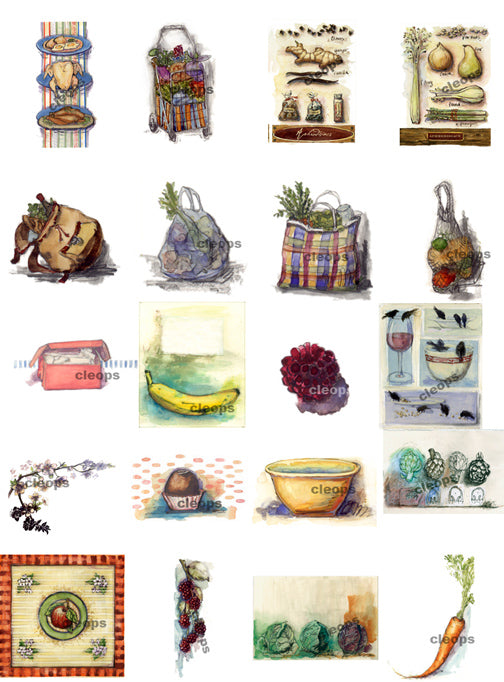

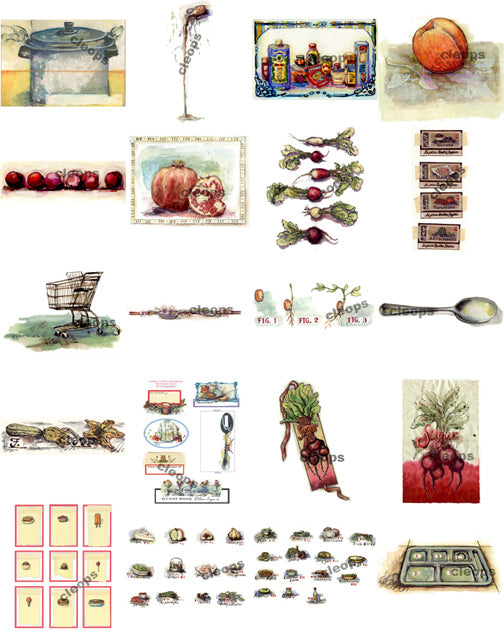
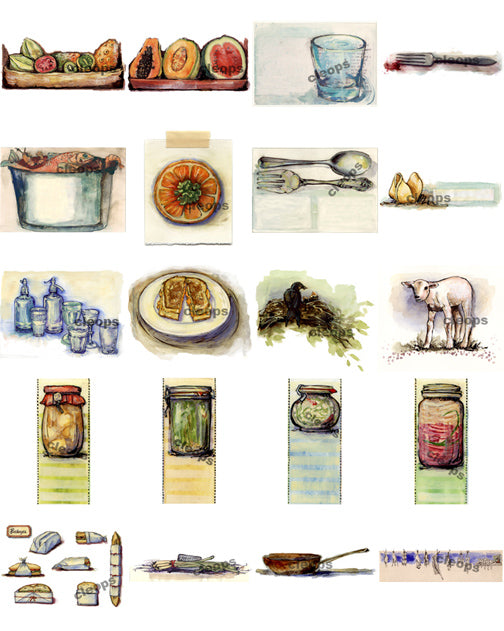

I'll be teaching book arts classes about kitchen notebooks, chef''s logs, and culinary travelogs at two locations: Sunday August 12th - Castle in the Air, Berkeley CA Three evenings starting Monday October 23rd - The San Francisco Center for the Book, San Francisco CA
Continue reading